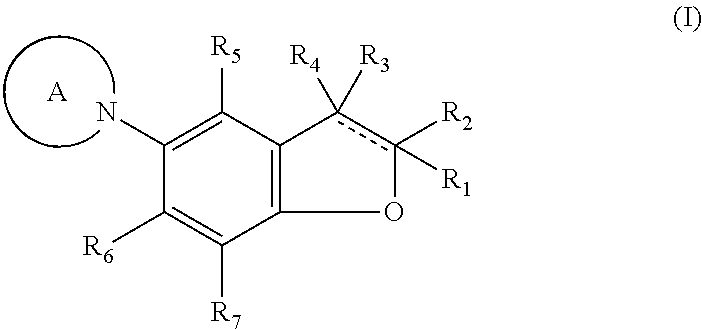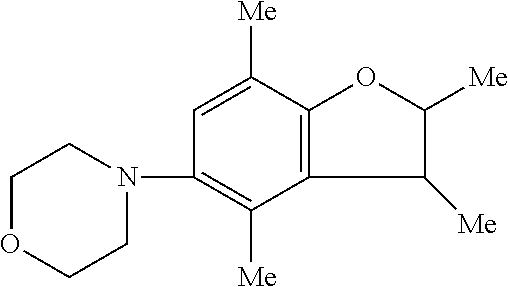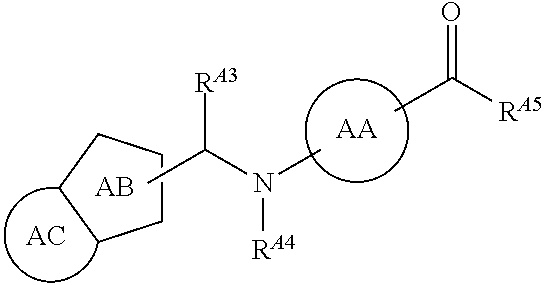Benzofuran derivatives
a technology of benzofuran and derivatives, applied in the field ofbenzofuran derivatives and a pharmaceutical agent, can solve the problems of not suppressing the progress of neurodegeneration, gradually losing the effect of l-dopa, etc., and achieves excellent neurogenesis promoting activity, low phototoxicity, and good neurogenesis.
- Summary
- Abstract
- Description
- Claims
- Application Information
AI Technical Summary
Benefits of technology
Problems solved by technology
Method used
Image
Examples
reference example 1
1,2,5-trimethyl-3-[(2-methylprop-2-en-1-yl)oxy]benzene
[1137]3-bromo-2-methylpropene (29.8 g, 221 mmol) was added to a mixture of DMF (130 mL) containing 2,3,5-trimethylphenol (25.0 g, 184 mmol) and potassium carbonate (50.9 g, 368 mmol), and the resulting mixture was stirred at 80° C. for 15 hours. After cooled to room temperature, the reaction solution was distributed using ethyl acetate and water. The organic layer was washed with saturated saline, and then dried using anhydrous magnesium sulfate. The solvent was removed under reduced pressure, and the obtained residue was purified by silica gel column chromatography (hexane-ethyl acetate 50:1 to 9:1) to give 33.6 g of the title compound (yield: 96%) as an oily product.
[1138]1H-NMR (CDCl3): δ1.84 (3H, s), 2.14 (3H, s), 2.23 (3H, s), 2.27 (3H, s), 4.39 (2H, s), 4.94-4.99 (1H, m), 5.09-5.14 (1H, m), 6.52 (1H, s), 6.61 (1H, s).
reference example 2
2,3,5-trimethyl-6-(2-methylprop-2-en-1-yl)phenol
[1139]A mixture of 1,2,5-trimethyl-3-[(2-methylprop-2-en-1-yl)oxy]benzene (33.6 g, 177 mmol) synthesized in Reference Example 1 and N,N-diethylaniline (100 mL) was stirred under argon atmosphere at 220 to 230° C. for 11 hours. After cooled to room temperature, the reaction solution was distributed using ethyl acetate and 1N hydrochloric acid. The organic layer was washed with 1N hydrochloric acid and saturated saline, and then dried using anhydrous magnesium sulfate. The solvent was removed under reduced pressure, and the obtained residue was purified by silica gel column chromatography (hexane-ethyl acetate 40:1 to 9:1) to give 28.6 g of the title compound (yield: 85%) as an oily product.
[1140]1H-NMR (CDCl3): δ1.77 (3H, s), 2.13 (3H, s), 2.22 (6H, s), 3.35 (2H, s), 4.70-4.75 (1H, s), 4.84-4.89 (1H, m), 5.07 (1H, s), 6.61 (1H, s).
reference example 3
2,2,4,6,7-pentamethyl-2,3-dihydro-1-benzofuran
[1141]A mixture of 2,3,5-trimethyl-6-(2-methylprop-2-en-1-yl)phenol (13.0 g, 68.3 mmol) synthesized in Reference Example 2, p-toluenesulfonic acid monohydrate (1.30 g, 6.83 mmol) and toluene (130 mL) was stirred under heated reflux for 1.5 hours. After cooled to room temperature, the reaction solution was distributed by addition of 1N sodium hydroxide aqueous solution. The organic layer was washed with 1N sodium hydroxide aqueous solution and saturated saline, and then dried using anhydrous magnesium sulfate. The solvent was removed under reduced pressure, and the obtained residue was purified by basic silica gel chromatography (hexane-ethyl acetate 49:1 to 24:1) to give 11.1 g of the title compound (yield: 85%).
[1142]1H-NMR (CDCl3): δ1.46 (6H, s), 2.07 (3H, s), 2.14 (3H, s), 2.19 (3H, s), 2.90 (2H, s), 6.48 (1H, s).
PUM
 Login to View More
Login to View More Abstract
Description
Claims
Application Information
 Login to View More
Login to View More - R&D
- Intellectual Property
- Life Sciences
- Materials
- Tech Scout
- Unparalleled Data Quality
- Higher Quality Content
- 60% Fewer Hallucinations
Browse by: Latest US Patents, China's latest patents, Technical Efficacy Thesaurus, Application Domain, Technology Topic, Popular Technical Reports.
© 2025 PatSnap. All rights reserved.Legal|Privacy policy|Modern Slavery Act Transparency Statement|Sitemap|About US| Contact US: help@patsnap.com



